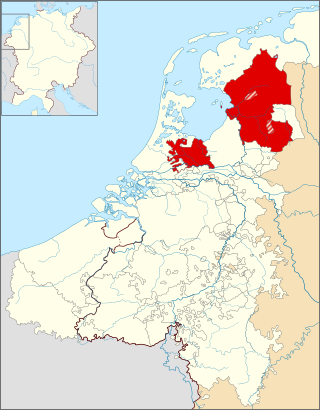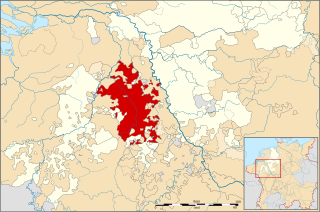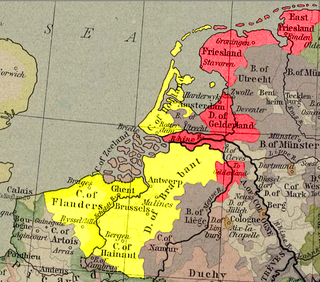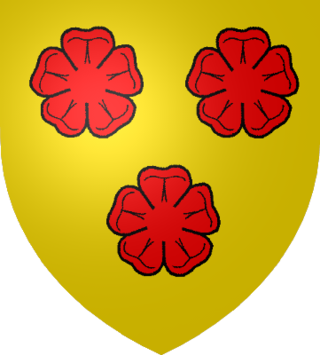
Gelderland, also known as Guelders in English, is a province of the Netherlands, located in the centre-east of the country. With a total area of 5,136 km2 (1,983 sq mi) of which 176 km2 (68 sq mi) is water, it is the largest province of the Netherlands by land area, and second by total area. Gelderland shares borders with six other provinces and the German state of North Rhine-Westphalia.

The Duchy of Guelders is a historical duchy, previously county, of the Holy Roman Empire, located in the Low Countries.

The Bishopric of Utrecht was an ecclesiastical principality of the Holy Roman Empire in the Low Countries, in the present-day Netherlands. From 1024 to 1528, as one of the prince-bishoprics of the Holy Roman Empire, it was ruled by the bishops of Utrecht.

The Duchy of Jülich comprised a state within the Holy Roman Empire from the 11th to the 18th centuries. The duchy lay west of the Rhine river and was bordered by the Electorate of Cologne to the east and the Duchy of Limburg to the west. It had territories on both sides of the river Rur, around its capital Jülich – the former Roman Iuliacum – in the lower Rhineland. The duchy amalgamated with the County of Berg beyond the Rhine in 1423, and from then on also became known as Jülich-Berg. Later it became part of the United Duchies of Jülich-Cleves-Berg.

John II was a Franco-Dutch nobleman who ruled lands in both France and the Holy Roman Empire. He was the count of Blois and Dunois from 1372 until 1381, the lord of Avesnes, Schoonhoven, Gouda, Beaumont, Chimay and Waarde from 1356 until 1381 and the stadtholder of Holland and Zeeland in 1359–1360 and 1362–1363 during the absences of Count Albert of Bavaria. He was also a claimant jure uxoris to the Duchy of Guelders from 1372 until 1379.

Arnold of Egmond was Duke of Guelders, Count of Zutphen.

The Guelders Wars were a series of conflicts in the Low Countries between the Duke of Burgundy, who controlled Holland, Flanders, Brabant, and Hainaut on the one side, and Charles, Duke of Guelders, who controlled Guelders, Groningen, and Frisia on the other side.

Guelders is a historical duchy, previously county, of the Holy Roman Empire, located in the Low Countries.

Reginald II of Guelders, called "the Black", was Count of Guelders, and from 1339 onwards Duke of Guelders, and Zutphen, in the Low Countries, from 1326 to 1343. He was the son of Reginald I of Guelders and Marguerite of Flanders.
Reginald III was Duke of Guelders and Count of Zutphen from 1343 to 1361, and again in 1371. He was the son of Reginald II of Guelders and of Eleanor of Woodstock, daughter of Edward II of England.

William was Duke of Guelders, as William I, from 1377 and Duke of Jülich, as William III, from 1393. William was known for his military activities, participating in the Prussian crusade five times and battling with neighbors in France and Brabant throughout his rule. His allies included Holy Roman Emperors, Charles IV and Wenceslaus, Richard II of England, and Conrad Zöllner von Rothenstein, the Grand Master of the Teutonic Knights. During his reign the duchies of Guelders and Jülich were temporarily unified.
Arnold II of Horne served as Prince and Bishop of Liège from 1378 until his death in 1389. He had previously served as Bishop of Utrecht from 1371 to 1378. Arnold was the son of Willem IV of Horne and Elisabeth of Cleves.

Reginald IV was the second duke to rule both Guelders and Jülich.
William II, Duke of Jülich was the second Duke of Jülich and the sixth William in the House of Jülich. He was the second son of William I of Jülich and Joanna of Hainaut.
Edward was the duke of Guelders and count of Zutphen from 1361 until 1371. Upon his brother Reginald becoming Duke of Guelders, Edward led a civil war culminating in the battle at Tiel, capturing his brother in 1361. Edward became Duke of Guelders, but in a dispute with Wenceslaus I of Luxembourg was killed at the battle of Baesweiler in 1371. His brother Reginald inherited the duchy from him.
The siege of Venlo in 1373 is one of the many sieges which the Dutch city of Venlo has known. This siege was the first in a long line of sieges which the city has known for centuries.
Marie of Guelders was one of two pretenders to the title of Duchess of Guelders and Countess of Zutphen on behalf of her son during the War of the Guelderian Succession from 1371 to 1379.

Willem VI of Horne was a Dutch Nobleman, the Lord of Horne.
Factionalism in the medieval Low Countries, in Dutch historiography known as partijstrijd or (partij)twisten, comprises several political, military and socio-economic conflicts in the Low Countries during the Middle Ages, especially the Late Middle Ages. The so-called 'parties' usually behaved like factions, which were formed ad hoc, could rapidly change in composition, and usually did not have strong ideological underpinnings. They were not officially organised political parties as would emerge in the 19th century. The parties were normally led by an aristocratic clan, followed by patrician families, and eventually several groups from the bourgeoisie, generally organised by guilds. These groups could often switch allegiances, names and goals, secede or defect, depending on how situations and interests evolved. Usually there were long-term tensions and only brief military confrontations, which either resulted in a new balance of power, or confirmed the status quo. The ruling dynasties or bishops could be dependent on the support from the strongest faction in order to govern, and in case of a war of succession, pretenders were compelled to ally themselves with one party or the other to stand a chance as seizing power. Foreign powers could interfere in factionalist struggles by providing financial or military support, and sometimes take over control of a province with the help of a local party.












